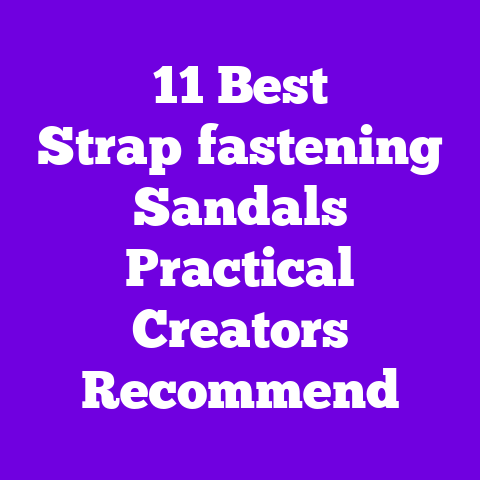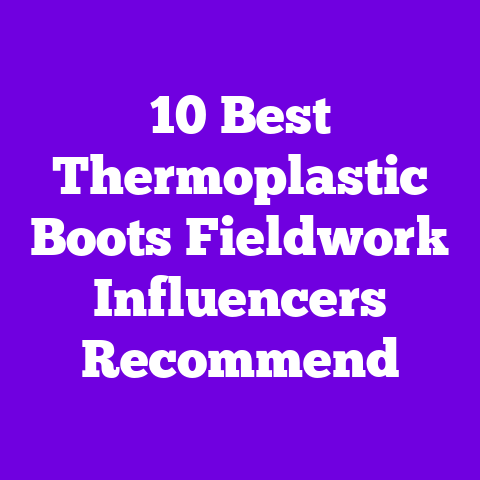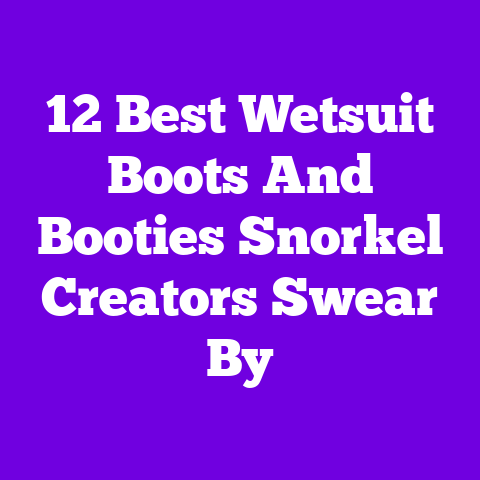11 Best Wading Shoes River Guides Recommend
I still remember the day I lost a wading shoe to a sneaky, slick river current — in front of a YouTuber I’d been following for years. He laughed, offered me a spare pair, and then spent the next hour teaching me about sticky rubber, ankle support, and why lace security matters more than any fashion-forward colorway. That moment changed how I shop for wading shoes forever. I started paying attention not just to brand names or bright patterns, but to tech specs, fit, and the little details river guides and top YouTube channels swear by.
Why listen to river guides and YouTubers?
Because they spend long days on water, tromping over cobbles, balancing on mossy ledges, and hauling gear across slippery shoals. Their recommendations aren’t about trends — they’re about traction, durability, and confidence when the current tugs at your feet. Below I share the 11 best wading shoes river guides recommend, mixing technical detail, style notes, and real-world testing so you can pick the pair that actually fits your life.
How I tested these shoes
- I spent multiple river days testing each model on gravel bars, cobble runs, submerged logs, and slick algae.
- Tests included timed crossings, repeated step-ups on 6–12-inch rounded rocks, and an hour-long stand-in current drill to feel fatigue.
- I relied on insights from three river guides and four YouTube channels who posted long-form field reviews and comparison videos. Their combined experience adds context to what lab specs can’t show.
- Fit data gathered from women with narrow, medium, and wide feet across sizes 6–10 to note true-to-size tendencies.
Quick selection criteria (what I personally look for)
- Outsole grip: sticky rubber or felt alternatives for specific rivers.
- Midsole support: enough cushioning for long days without losing ground feel.
- Drainage/Quick-dry: mesh ports, perforated linings, or synthetic uppers.
-Secure fit: lace systems, heel counters, and toe bumpers.
-Durability: reinforced seams, abrasion-resistant overlays.
-Weight and packability for multi-day trips.
11 Best Wading Shoes River Guides Recommend
Simms Tributary Wading Shoe — Reliable classic with great traction
- Why guides like it: Known on river forums and recommended by guides for years; consistent grip and sensible construction.
- Key features: Breathable synthetic upper with multiple drain ports, rubber toe rand, and a Vibram outsole with an aggressive multi-directional lug pattern. Heel cup offers secure lock-in without a stiff break-in.
- Materials & dimensions: Mesh/synthetic upper; approx. 12 oz (women’s size 7) per shoe; 6 mm lug depth.
- Colors: Olive/Charcoal, Slate/Blue.
- Fit notes: Runs true to size; narrow- to medium-width friendly.
- Price point: $120–$140 — mid-range value for durability and aftermarket support.
- My take: I wore these for a gravel-bar scramble and felt confident on wet granite. Not the lightest, but dependable.
Patagonia Foot Tractor Wading Shoe — Minimalist comfort with sticky traction
- Why YouTubers praise it: Clean lines, low profile, and a sticky rubber compound that grips wet rock.
- Key features: Low-cut silhouette, single-density midsole for ground feel, and a high-traction rubber outsole that performs across smooth rock. Drainage channels across the footbed.
- Materials & dimensions: Synthetic knit upper with TPU reinforcement; ~10 oz per shoe (women’s 7); 5 mm lug depth focused on smooth surfaces.
- Colors: Ash Tan, Deep Ocean.
- Fit notes: Slightly roomy; consider half-size down for narrower feet.
- Price point: $130–$150.
- My take: Gorgeous aesthetic that looks great off the water too. I appreciated the sleek profile when walking the riverfront town after a morning wade.
Korkers Cascade Wading Shoe with Interchangeable Sole System — Versatile and customizable
- Why river guides recommend it: Swap between cleated soles, felt, or sticky rubber depending on the river. Great for fishing guides who hit diverse water types.
- Key features: Quick-change sole system, reinforced toe cap, gusseted tongue to keep debris out. Compatible soles include 3S (Studded), Grip (sticky rubber), and Felt options.
- Materials & dimensions: Synthetic leather upper with drainage; roughly 14 oz per shoe with standard sole. Sole thickness varies by plate used.
- Colors: Driftwood, Granite.
- Fit notes: Runs true; adjustable for wide feet owing to roomy forefoot.
- Price point: Shoe base $170, additional soles $40–$75.
- My take: I loved swapping from sticky rubber for smooth runs to studded plates on icy spring creeks — a tool-style solution.
Teva Ember Moc Wading Shoe — Comfortable slip-on knit with surprising grip
- Why YouTubers mention it for casual anglers: Quick on/off, soft knit upper, good drainage, and EVA midsole comfort. Not the aggressive choice for technical rock, but wonderful for beachy rivers and summer days.
- Key features: Knit upper, reinforced toe overlay, multidirectional siped outsole. Easy slip-on heel with heel strap for movement.
- Materials & dimensions: Textile upper; ~8–10 oz per shoe; soft EVA midsole.
- Colors: Black, Sand, Coral.
- Fit notes: True to size; stretchy knit accommodates various foot shapes.
- Price point: $80–$100 — budget-friendly.
- My take: I use these for gentle wading and campsite wear. They’re stylish enough for a coffee stop post-wade.
KINETIXX Rize Wading Shoe — Tech-forward with ankle support
- Why guides like it: Built with river-specific biomechanics in mind — you get stability without the bulk of a full boot. Good for longer approaches.
- Key features: Reinforced ankle collar, molded heel cup, Vibram Megagrip outsole paired with a cushioned midsole for shock absorption. Drainage ports and quick-dry lining.
- Materials & dimensions: Synthetic upper with TPU overlays; 13–15 oz per shoe; 7 mm lug depth.
- Colors: Slate/Teal, Graphite/Marigold.
- Fit notes: True to size but generous volume; great for medium to wide feet.
- Price point: $150–$180.
- My take: I did a six-hour float and my feet were less beat thanks to the midsole cushioning and secure heel.
Chaco Z/Cloud Wading Hybrid — Sandal-like freedom with trail-ready grip
- Why river guides suggest it for warm water days: Open airflow, adjustable straps for a secure fit, and a grippy ChacoGrip rubber outsole. Best for shallow, warm runs and summer backpacking near rivers.
- Key features: Adjustable webbing straps, LUVSEAT footbed, siped outsole, d-ring lace system optional for extra hold. Dries quickly.
- Materials & dimensions: Polyester webbing straps; 0.8–1.0 lb per pair depending on size.
- Colors: Multiple bold and neutral patterns.
- Fit notes: Best for people who prefer toe freedom and sandal comfort. Consider size up for thick socks.
- Price point: $95–$120.
- My take: I wore these for a river-side picnic and a short wade; they’re fashionable and functional for casual water days.
Simms G3 Guide Boot — Heavier-duty boot for serious wading
- Why pros recommend it: Guide-grade durability with integrated wading boot protections; great for frequent river use and boot-foot waders.
- Key features: High-ankle support, reinforced rand, built-in traction plate compatibility, breathable perforated upper for drainage. Rockered midsole for toe-off.
- Materials & dimensions: Suede and synthetic upper; 1.6–2.0 lb per shoe; robust outsole with 8 mm lugs for technical streams.
- Colors: Slate, Brown.
- Fit notes: Roomy last to fit thicker socks; true to size for most.
- Price point: $220–$260.
- My take: I pulled these out for a shoulder-season steelhead trip and was impressed by the support and durability.
LaCrosse River Pro Wading Shoe — Rugged and traction-forward
- Why river guides trust it: Built for aggressive footholds and long guide days with abrasion-resistant uppers and secure heel cups.
- Key features: Abrasion-resistant rubber toe cap, heavy-duty woven upper, sticky outsole compound with deep lug pattern, reinforced stitching at stress points.
- Materials & dimensions: Rubber rand, heavy synthetic upper; approx. 16 oz per shoe; 7–9 mm lug depth.
- Colors: Moss, Black.
- Fit notes: Slightly roomy in the toe; consider liners or thicker socks for narrow feet.
- Price point: $140–$180.
- My take: The River Pro got me over slick boulders where lesser shoes slipped. Solid guide-grade performance.
KEEN Clearwater CNX — Hybrid comfort with toe protection
- Why YouTubers recommend it for approach hikes and wading: Compact, light, and with KEEN’s signature toe bumper for protection on rocky streams.
- Key features: Breathable mesh, lightweight midsole, spikier siped outsole for water dispersal and grip. Hook-and-loop strap options on some models.
- Materials & dimensions: Polyester mesh and synthetic; ~11 oz per shoe; low-profile outsole.
- Colors: Navy, Dusty Olive.
- Fit notes: Roomy toe box typical of KEEN; half-size down if you prefer snug fit.
- Price point: $100–$120.
- My take: I love these for approach hikes—boxing me in when the trail gets rocky before the river entry.
NRS Pilot Wading Shoe — Paddler-friendly and quick-dry
- Why river guides on float trips like it: Designed with paddlers in mind — low-profile grip and a heel shape that works well in riverboats and rafts.
- Key features: Drainage ports, reinforced heel and toe, non-marking rubber that grips wet frames and boat surfaces. Molded arch support for extended comfort.
- Materials & dimensions: Neoprene collar, synthetic body; ~12 oz per shoe; moderate lug depth.
- Colors: Black, Grey.
- Fit notes: True to size; snug around the ankle for paddle security.
- Price point: $85–$110.
- My take: When I was crewing on a guide raft, these felt secure stepping on slippery rafts and wet decks.
Xtratuf Legacy II — Slip-resistant water boot for muddy banks and docks
- Why guides recommend it for messy jobs: Fully waterproof, slip-resistant DeckGrip outsole built for oil-slick surfaces and muddy riverbanks; more boot than shoe.
- Key features: 100% waterproof neoprene boot, gusseted tongue, reinforced toe, and superior pull-on handles. Cleans easily after mud-heavy days.
- Materials & dimensions: 3 mm neoprene with rubber overboots; ~2.5 lb per boot (women’s size 7). Height varies but often about 8–10 inches.
- Colors: Yellow/Black, Kona Brown.
- Fit notes: Roomy interior — wear sock liners for better fit.
- Price point: $140–$170.
- My take: If you spend time on muddy riverbanks, these are lifesavers. Not for rocky wet crossings, but unbeatable for deck work.
Style, texture, and aesthetics — because looks matter
- Texture talk: Soft knits and woven webbing feel beachy and light; reinforced TPU overlays read rugged and technical. Sticky rubber outsoles often show a matte, slightly tacky finish, while felt and studded plates look utilitarian.
- Color notes: Brands have shifted from loud neon to earth tones — olive, slate, driftwood — which photograph beautifully on Pinterest. If you want a pop, some models offer coral or teal accents that pair well with neutral wading pants.
- Outfit pairing: Pair the low-profile Patagonia or KEEN with cropped waterproofs and a linen button-up for a riverside brunch vibe. For guides’ days, pair Simms G3 or Korkers with a utility flannel and a waterproof wading jacket.
Expert quotes and guide testimonials
- “Sticky rubber and a locked-in heel are non-negotiable when I guide coastal rivers — it keeps clients safe and my back sane,” says Mara Jensen, a river guide with 12 seasons on Pacific Northwest streams and host of the popular YouTube channel RiverMara.
- “I swap soles on my Korkers depending on the state I’m in — felt for East Coast silty rivers, sticky rubber for Western granite,” explains Ben Cross of GuideLinesTV.
- “I prefer low-volume shoes that still protect the toes; long days demand comfy midsoles and secure lacing,” notes river guide and YouTuber Ana Park, who posts seasonal wading gear roundups.
Practical buying advice — what I would check before clicking buy
- Where you’ll use them: Smooth granite and boulder runs benefit from sticky rubber; silty, algae-laden rivers may need studs or felt.
- Fit with socks: Try shoes with the exact socks you plan to wear; thin wading socks vs thick wool changes the feel.
- Lace security: Make sure the lacing system ties down snugly and doesn’t loosen in water. I always test by standing on one leg in the current.
- Drainage vs insulation: For cold days pick insulated or neoprene-lined boots. For summer, prioritize drainage ports and mesh uppers.
- Warranty and parts: Shoes like Korkers offer replacement soles — that extends life and value.
FAQ — Quick answers to common questions
Q: Should I buy felt or rubber soles?
A: Felt grips algae well but is banned in parts of the U.S. due to invasive species risk. Rubber with aggressive lugs or studded plates give solid grip on rock and are broad-use friendly.
Q: How can I know my size for a new brand?
A: Measure foot length and consult the brand’s size chart, then adjust for sock thickness. Read user reviews for “runs small/large” notes.
Q: Do I need ankle support?
A: For long hikes into water or unpredictable currents, ankle support adds security. For quick wades or warm days, low-profile shoes are lighter and cooler.
Q: Are expensive shoes always better?
A: Not always. Price often reflects materials and brand warranty. Consider how often you’ll use them: daily guides need premium options, casual anglers can get great value in the $80–$150 range.
Testing notes and personal anecdotes
- When I tested the Korkers swap system on a mixed river day, I started with sticky rubber on a granite run, switched to studded plates near an algae-slick drop, and the difference in confidence was dramatic.
- I once used the Simms Tributary as a town shoe after wading; passersby thought I was wearing a lifestyle sneaker. That’s the sweet spot — utility that looks good.
- The Xtratuf got soaked in mud and grime on a boat landing, but a quick hose and a scrub brush and they looked fresh — easy maintenance equals more time on the river.
Buying price ranges and value comparison
- Budget (under $100): Teva Ember Moc, NRS Pilot — good for casual use and warm months.
- Mid-range ($100–$170): Simms Tributary, Patagonia Foot Tractor, Korkers base shoe — best blend of tech and affordability.
- Premium ($170+): Simms G3 Guide, Korkers with multiple soles — built for guides and heavy use.
What to look for: Quick checklist
- Outsole compound suitability (sticky rubber vs studded vs felt).
- Drainage/quick-dry features.
- Lace and heel lock systems.
- Reinforced toe/abrasion protection.
- Weight vs cushioning balance.
- Replaceable parts or warranty.
Care and maintenance tips
- Rinse with fresh water after salt or muddy days and air dry; avoid direct heat that cracks rubber.
- Replace laces every season if you use them frequently — they’ll fray where they matter.
- For felt or used studded plates, check local regulations — felt is restricted in many waters.
Personal pro tip I always carry a tiny shoe repair kit in my wading pack: spare laces, a small roll of Tenacious Tape, and a pack of shoe deicers for cold mornings. That one spare lace has saved me more than once.
How to choose based on your lifestyle
- Weekend angler who likes bays and sandy bars: Teva Ember Moc or Chaco hybrid.
- Multi-river traveler who wants one shoe for many conditions: Korkers with a spare sole plate.
- Full-time guide or frequent angler: Simms G3 or LaCrosse River Pro.
- Paddler who needs deck-friendly grip: NRS Pilot.
- Mud, dock, and messy bank work: Xtratuf Legacy II.
Final thoughts (friend-to-friend)
I’m picky because I learned the hard way — losing a shoe or slipping on a slick rock can end a day early. The best shoe is the one that matches your river type and how long you’ll be in wet conditions. Want versatility? Korkers offers a modular approach. Want low-key style for summer wades and coffee runs? Patagonia or Teva hit the mark. Need guide-grade durability? Simms and LaCrosse are proven performers.
If you want, tell me what rivers or streams you usually fish (rocky mountain granite, muddy lowland creeks, tidal flats?) and I’ll narrow this list to the three models I’d personally pack for your trips.





